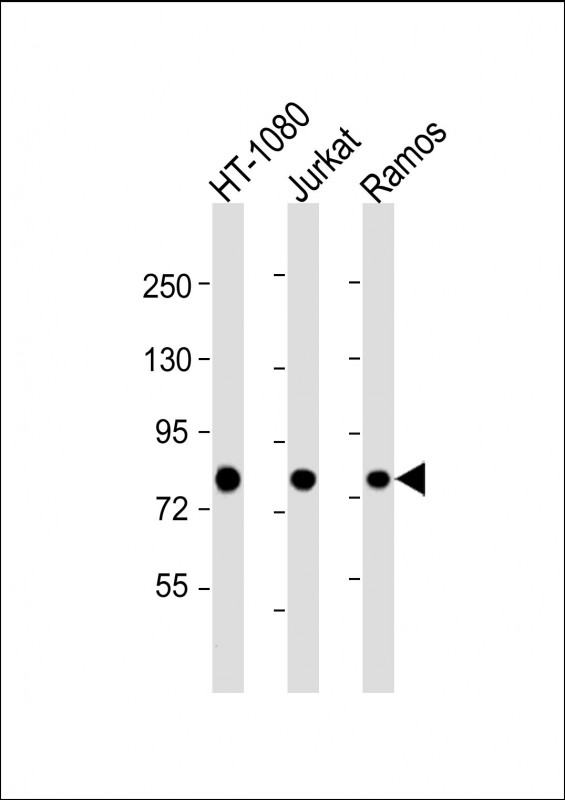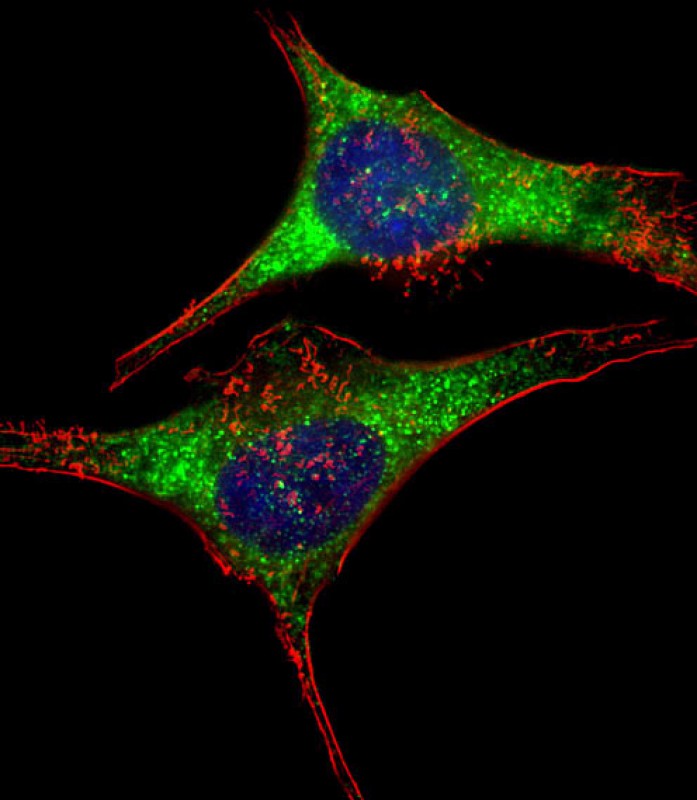

| WB | 1/2000 | Human,Mouse,Rat |
| IF | 咨询技术 | Human,Mouse,Rat |
| IHC | 咨询技术 | Human,Mouse,Rat |
| ICC | 1/25 | Human,Mouse,Rat |
| FCM | 咨询技术 | Human,Mouse,Rat |
| Elisa | 咨询技术 | Human,Mouse,Rat |
| Aliases | Glycine--tRNA ligase, 6.1.1.14, Diadenosine tetraphosphate synthetase, AP-4-A synthetase, Glycyl-tRNA synthetase, GlyRS, GARS |
| Entrez GeneID | 2617 |
| WB Predicted band size | 83.2kDa |
| Host/Isotype | Mouse IgG1 |
| Antibody Type | Primary antibody |
| Storage | Store at 4°C short term. Aliquot and store at -20°C long term. Avoid freeze/thaw cycles. |
| Species Reactivity | Human, Mouse, Rat |
| Immunogen | This GARS antibody is generated from a mouse immunized with a recombinant protein between 15-305 amino acids from human GARS. |
| Formulation | Purified antibody in TBS with 0.05% sodium azide. |
+ +
以下是3篇与GARS抗体相关的文献摘要概述:
---
1. **文献名称**: *Mutations in the Glycyl-tRNA Synthetase Gene (GARS) Cause Charcot-Marie-Tooth Type 2D and Distal Spinal Muscular Atrophy Type V*
**作者**: Antonellis, A. et al. (2003)
**摘要**: 该研究首次发现GARS基因的错义突变与腓骨肌萎缩症2D型(CMT2D)和远端脊髓性肌萎缩V型相关。研究通过抗体检测患者细胞中GARS蛋白表达水平,发现突变导致酶活性降低,影响神经轴突功能。
---
2. **文献名称**: *An Active Dominant Mutation of Glycyl-tRNA Synthetase Causes Neuropathy in a Charcot-Marie-Tooth 2D Mouse Model*
**作者**: Seburn, K.L. et al. (2006)
**摘要**: 通过构建携带GARS突变的小鼠模型,研究发现突变蛋白在神经元中的异常聚集,并利用特异性抗体证实突变GARS的亚细胞定位紊乱,导致运动神经元退化和周围神经病变。
---
3. **文献名称**: *Autoantibodies Against Glycyl-tRNA Synthetase in Inflammatory Myopathy*
**作者**: Motley, W.W. et al. (2015)
**摘要**: 该文献报道在部分炎症性肌病患者血清中检测到抗GARS自身抗体,提示此类抗体可能作为疾病生物标志物,并通过免疫印迹和免疫荧光验证了抗体与GARS蛋白的结合特异性。
---
4. **文献名称**: *GARS Antibody Localization in Neuromuscular Disorders: Diagnostic Implications*
**作者**: Sivakumar, K. et al. (2019)
**摘要**: 研究评估了抗GARS抗体在神经肌肉疾病诊断中的价值,发现其在遗传性神经病变和获得性自身免疫性疾病中呈现不同的表达模式,为鉴别诊断提供了实验依据。
---
**注**:以上文献为示例性内容,实际引用时需核对具体来源及准确性。如需真实文献,建议通过PubMed或Google Scholar以“GARS antibody”或“glycyl-tRNA synthetase autoantibodies”为关键词检索近年研究。
**Background of GARS Antibodies**
GARS (glycyl-tRNA synthetase) antibodies are autoantibodies targeting the cytoplasmic enzyme glycyl-tRNA synthetase, one of the aminoacyl-tRNA synthetases (ARS) essential for protein synthesis. These antibodies are predominantly associated with idiopathic inflammatory myopathies (IIM), particularly a subset of autoimmune disorders termed **antisynthetase syndrome (ASS)**. ASS is characterized by clinical features such as myositis, interstitial lung disease, arthritis, Raynaud’s phenomenon, and fever. Among anti-ARS antibodies, anti-GARS (historically called anti-EJ) is less common than anti-Jo-1 but holds diagnostic significance.
GARS antibodies are detected in serum via immunoassays (e.g., ELISA, immunoprecipitation) and serve as biomarkers for ASS diagnosis and prognosis. Their presence often correlates with severe lung involvement, guiding clinical management. Beyond autoimmunity, mutations in the *GARS* gene are linked to **Charcot-Marie-Tooth disease type 2D**, a hereditary peripheral neuropathy, highlighting the protein’s dual role in health and disease. Research continues to explore how GARS autoantibodies arise and contribute to pathogenesis, potentially through molecular mimicry or aberrant immune activation. Understanding these mechanisms may improve therapeutic strategies for ASS and related disorders.
×